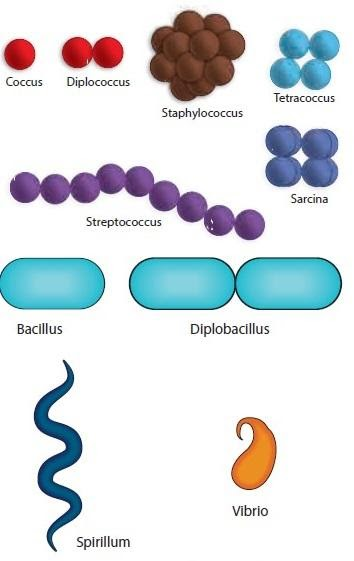
Draw neat and labelled diagrams?
a) Different types of bacteria.
Answer
497.1k+ views
Hint: As we all are very well acquainted with the term bacteria or the organism. Bacteria are a very common and important part of the ecosystem or even other organisms like human beings. Bacteria belonged to the kingdom Monera which is the first classification. Bacteria is used world-wide as a source of food and it is infectious too. There are good bacteria and bad bacteria. Good bacteria are the bacteria used in culturing or producing in food supplements like probiotics.
Complete explanation:
Bacteria belong to Monera classification. There are different shapes and sizes of bacteria present in the living world. Some are thermophiles, acidophiles, varying in temperature. Thermophile’s bacteria are kinds of bacteria which live in hot and humid regions. They sustain in hot springs and have adaptation to hotter environments. Acidophile’s bacteria are acidic in nature; they can live in PH below \[6\]. Example – the gut bacteria present in other larger animals. Similarly, bacteria which live in basic conditions or alkaline environments are called alkaliphiles.
Bacteria are typically a cell depending on its size it can be small or large. Different types of bacteria depending on structure are- coccus, bacillus, spirillum, vibrio. Coccus as the name suggests is circular in form or has an oval shape. Bacillus is rod shaped. Spirillum is spiral shaped. Vibrio is comma shaped. Bacteria are the first components to be visible on earth.
As we discussed earlier, what are good and bad bacteria? Bad bacteria are the bacteria which causes illness in out body like- food indigestion, food poisoning, cholera, jaundice etc.

Note:
As we discussed shapes and sizes bacteria comes in, bacteria are an important aspect of the subject microbiology. Still yet many scientists are researching new factors about bacteria, how it can be used in RD technologies, for human development, how to minimize the exploitation of good bacteria etc.
Complete explanation:
Bacteria belong to Monera classification. There are different shapes and sizes of bacteria present in the living world. Some are thermophiles, acidophiles, varying in temperature. Thermophile’s bacteria are kinds of bacteria which live in hot and humid regions. They sustain in hot springs and have adaptation to hotter environments. Acidophile’s bacteria are acidic in nature; they can live in PH below \[6\]. Example – the gut bacteria present in other larger animals. Similarly, bacteria which live in basic conditions or alkaline environments are called alkaliphiles.
Bacteria are typically a cell depending on its size it can be small or large. Different types of bacteria depending on structure are- coccus, bacillus, spirillum, vibrio. Coccus as the name suggests is circular in form or has an oval shape. Bacillus is rod shaped. Spirillum is spiral shaped. Vibrio is comma shaped. Bacteria are the first components to be visible on earth.
As we discussed earlier, what are good and bad bacteria? Bad bacteria are the bacteria which causes illness in out body like- food indigestion, food poisoning, cholera, jaundice etc.

Note:
As we discussed shapes and sizes bacteria comes in, bacteria are an important aspect of the subject microbiology. Still yet many scientists are researching new factors about bacteria, how it can be used in RD technologies, for human development, how to minimize the exploitation of good bacteria etc.
Recently Updated Pages
Why are manures considered better than fertilizers class 11 biology CBSE

Find the coordinates of the midpoint of the line segment class 11 maths CBSE

Distinguish between static friction limiting friction class 11 physics CBSE

The Chairman of the constituent Assembly was A Jawaharlal class 11 social science CBSE

The first National Commission on Labour NCL submitted class 11 social science CBSE

Number of all subshell of n + l 7 is A 4 B 5 C 6 D class 11 chemistry CBSE

Trending doubts
What is meant by exothermic and endothermic reactions class 11 chemistry CBSE

10 examples of friction in our daily life

One Metric ton is equal to kg A 10000 B 1000 C 100 class 11 physics CBSE

1 Quintal is equal to a 110 kg b 10 kg c 100kg d 1000 class 11 physics CBSE

Difference Between Prokaryotic Cells and Eukaryotic Cells

What are Quantum numbers Explain the quantum number class 11 chemistry CBSE




